UMass Extension's Landscape Message is an educational newsletter intended to inform and guide Massachusetts land care professionals in the management of our collective landscape. Detailed reports from scouts and Extension specialists on growing conditions, pest activity, and cultural practices for the management of woody ornamentals, trees, and turf are regular features. The following issue has been updated to provide timely management information and the latest regional news and environmental data.
Welcome to Landscape Message #5 for the 2024 growing season. The next message will be published in one week, on May 17. To receive immediate notification when the next Landscape Message update is posted, be sure to join our e-mail list
Click on the headings below to jump to that section of the message.
In This Issue
Scouting Information by Region
Woody Ornamentals
Scouting Information by Region
Environmental Data
The following data was collected on or about May 8, 2024. Total accumulated growing degree days (GDD) represent the heating units above a 50ºF baseline temperature collected via regional NEWA stations (http://newa.cornell.edu) for the 2024 calendar year. This information is intended for use as a guide for monitoring the developmental stages of pests in your location and planning management strategies accordingly.
|
MA Region/Location |
2024 Growing Degree Days |
Soil Temp |
Precipitation |
Time/Date of Readings |
||
| Gain since last report |
2024 total |
Sun |
Shade |
|||
|
CAPE |
26 |
53 |
51 |
50 |
0.44 |
12:00 PM 5/8/2024 |
|
SOUTHEAST |
38 |
103 |
61 |
53 |
0.50 |
3:00 PM 5/8/2024 |
|
NORTH SHORE |
25 |
49 |
52 |
46 |
0.65 |
2:30 PM 5/8/2024 |
|
EAST |
46 |
100 |
54 |
50 |
0.81 |
4:00 PM 5/8/2024 |
|
METRO |
44 |
93 |
51 |
48 |
0.64 |
3:30 PM 5/8/2024 |
|
CENTRAL |
44 |
95 |
52 |
50 |
1.09 |
2:00 PM 5/8/2024 |
|
PIONEER VALLEY |
57 |
123 |
58 |
52 |
1.10 |
10:00 AM 5/8/2024 |
|
BERKSHIRES |
52 |
108 |
58 |
54 |
1.06 |
6:00 AM 5/8/2024 |
|
AVERAGE |
42 |
91 |
55 |
50 |
0.79 |
- |
|
n/a = information not available |
||||||
US Drought Monitor: No change from last week... at this time, no area of Massachusetts is under official drought status. State map as of Thursday 5/9: https://droughtmonitor.unl.edu/CurrentMap/StateDroughtMonitor.aspx?MA
Phenology
| Indicator Plants - Stages of Flowering (BEGIN, BEGIN/FULL, FULL, FULL/END, END) | ||||||||
|---|---|---|---|---|---|---|---|---|
| PLANT NAME (Botanic / Common) | CAPE | S.E. | N.S. | EAST | METRO W. | CENT. | P.V. | BERK. |
|
Elaeagnus umbellata (autumn olive) |
* |
Begin |
* |
* |
Begin |
Begin |
Begin |
* |
|
Spiraea x vanhouttei (Vanhoutte spirea) |
Begin |
Full |
Begin |
Begin |
Begin/Full |
Begin/Full |
Full |
* |
|
Syringa vulgaris (common lilac) |
Begin |
Begin |
Begin |
Begin |
Begin |
Begin |
Full |
Begin |
|
Cornus florida (flowering dogwood) |
Begin/Full |
Begin |
Full |
Begin/Full |
Full |
Full |
Full |
Begin/Full |
|
Rhododendron spp.(early azaleas) |
Begin/Full |
Begin |
Full/End |
Full/End |
Full/End |
Full |
Full/End |
Full |
|
Malus spp. (crabapple) |
Begin/Full |
Full |
Begin |
Begin |
Full |
Full |
Full |
Begin/Full |
|
Cercis canadensis (redbud) |
Begin/Full |
Begin |
Begin/Full |
Begin/Full |
Full |
Begin/Full |
Full |
Begin/Full |
|
Amelanchier spp. (shadbush, serviceberry) |
Full |
End |
Full/End |
End |
End |
End |
End |
Full/End |
|
Pyrus calleryana (Callery pear) |
Full/End |
End |
Full/End |
End |
End |
End |
End |
Full/End |
| * = no activity to report/information not available | ||||||||
Regional Notes
Cape Cod Region (Barnstable)
General Conditions: The average temperature for the period from May 1–May 8 was 51ºF with a high of 70ºF on May 6 and a low of 38ºF on May 4. We experienced a mixed bag of weather with some very cool days and some warm days. The period was mostly cloudy and precipitation fell on several days, totaling just over a half inch. Soil moisture is adequate. Soil temperatures have just started to average near 55ºF this week.
Herbaceous plants seen in bloom include tulips (Tulipa spp.), barrenwort (Epimedium spp.), Siberian bugloss (Brunnera macrophylla), basket of gold (Aurinia saxatilis), moss phlox (Phlox subulata) and bleeding heart (Lamprocapnos spp.). Woody plants seen in bloom include Japanese cherry (Prunus serrulata ‘Kanzan’), forsythia (Forsythia spp.), saucer magnolia (Magnolia x soulangeana), and flowering quince (Chaenomeles speciosa). Some black oaks are starting to flower.
Pests/Problems: Box tree moth was discovered in several towns of the upper Cape last season. This insect is capable of defoliating boxwood if left unmanaged. Box tree moth is active and should be scouted for. Find more info in the UMass Extension Box Tree Moth fact sheet.
Winter moth caterpillars have been hard to come by in my scouting in the upper Cape region. Black turpentine beetle damage to pitch pine has been observed; trees attacked last season that remain green all winter often brown quickly at this time of year. Dieback on umbrella pine has been observed on numerous plants, Maskell scale is very present on symptomatic plants. Cryptomeria scale was observed on fir and leafminer damage was found on boxwood.
Disease symptoms observed during the period include fungal leaf spot on mountain laurel and white pine needle decline on white pine.
Last week's freeze did result in damage to many plants including hydrangea; in most cases the damage is minor.
Invasive plants in bloom include garlic mustard (Alliaria petiolata) and leafy spurge (Euphorbia esula). Other weeds seen in bloom include dandelions (Taraxacum officinale), yellow rocket (Barbarea vulgaris), narrow-leaved plantain (Plantago lanceolata), and speedwells (Veronica spp.)
Slugs and snails are actively feeding Oriental lily, hosta, and bearded iris.
Southeast Region (Dighton)
General Conditions: Temperatures over the past week have been seasonal, but conditions remain dry. The highest temperature recorded was 67ºF on Monday afternoon, May 6th, while the lowest was the 44ºF on the morning of Saturday, May 4th. The average temperature for the week was 55ºF, while humidity averaged 87%. The highest windspeed reached 12 mph from the south on Sunday afternoon, May 5th. There were rain showers that Sunday evening, the 5th, and again on Wednesday, May 8th. Total precipitation for the week was 1.15 inches. The soil temprature was 60ºF in full sun and 55ºF in the shade at 3:00 PM on May 8th.
Among the many plants in flower are: Cercis canadensis (redbud), Chaenomeles speciosa (common flowering quince), Cornus florida (flowering dogwood), Elaeagnus umbellata (Autumn-olive), Lonicera tatarica (Tatarian honeysuckle), Malus spp. (crabapple), Prunus serrulata (Japanese flowering cherry), Pyrus calleryana (Callery pear), Rhododendron mucronulatum (Korean rhododendron), Rhododendron 'P. J. M.', Rhododendron spp. (early azaleas), Spiraea x vanhouttei (Vanhoutte spirea), Syringa vulgaris (common lilac), and Viburnum spp. (early fragrant viburnums)
Pests/Problems: Eastern tent caterpillar nests are appropriately ten inches in diameter and common in black cherry. European pine sawfly larvae are at second instar and feeding on last year's needles of mugo pine. Snowball aphids are abundant on fragrant viburnum and producing characteristic leaf cupping.
While the US Drought Monitor is not yet reporting drought conditions for Bristol County, those of us who are digging are finding topsoils are dry.
Peak tick activity will continue through to August. Potentially deadly Powassan virus is now present in ticks in Massachusetts. Black legged ticks are the most likely vector.
North Shore (Beverly)
General Conditions: Temperatures during this week's reporting period were variable. Day temperatures ranged from 49ºF to 72ºF, and night temperatures ranged from 41ºF to 50ºF. The average daily temperature for this period was 51ºF with the maximum temperature of 72ºF recorded on May 6 and minimum temperature of 41ºF recorded on May 4. Approximately 0.81 inch of rainfall was recorded at Long Hill. Due to the continued rains, the soil is moist, lawns are green, and turf is thriving. Homeowners and landscapers have started mowing lawns. Many groups in the area are organizing spring plant sales for the week. Multiple plant species continue to be in full bloom and others are beginning to bloom. Woody plants in full bloom include mountain pieris (Pieris floribunda), flowering dogwood (Cornus florida), redbud (Cercis canadensis), large Fothergilla (Fothergilla major), royal azalea (Rhododendron schlippenbachii), common lilac (Syringa vulgaris), Kwanzan cherry (Prunus serrulata), cucumber tree magnolia (Magnolia acuminata), crabapple (Malus spp.), hardy orange (Poncirus trifoliata), and highbush blueberry (Vaccinium corymbosum). Non-woody plants seen in bloom include daffodil (Narcissus spp.), forget-me-not (Myosotis sylvatica), tulips (Tulipa sp.), bleeding heart (Dicentra spectabilis), Pachysandra (Pachysandra procumbens), and Vinca vine (Vinca major).
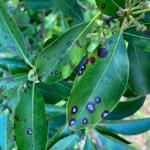
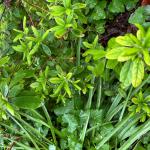 Pests/Problems: Fungal leaf spot of mountain laurel was observed on some shrubs in the landscape. Soil pH-induced iron deficiency symptoms were observed on some azaleas. Invasive weeds garlic mustard (Alliaria petiolata) and lesser celandine (Ranunculus ficaria) are in full bloom. Other problematic weeds in bloom include dandelion (Taraxacum officinale) and violets (Viola spp). Ticks are already active. Be careful to protect yourself with tick repellent when working outdoors, and to check yourself thoroughly after being outdoors in the woods or tall grasses.
Pests/Problems: Fungal leaf spot of mountain laurel was observed on some shrubs in the landscape. Soil pH-induced iron deficiency symptoms were observed on some azaleas. Invasive weeds garlic mustard (Alliaria petiolata) and lesser celandine (Ranunculus ficaria) are in full bloom. Other problematic weeds in bloom include dandelion (Taraxacum officinale) and violets (Viola spp). Ticks are already active. Be careful to protect yourself with tick repellent when working outdoors, and to check yourself thoroughly after being outdoors in the woods or tall grasses.
East (Boston)
General Conditions: Daytime temperatures averaged 63ºF over the past week. We reached a season high of 78ºF on the sixth, and overnight lows averaged 47ºF. We received 0.41 inches of precipitation. The landscape is noticeably greener; grasses are gaining height, and trees and shrubs are leafing out. Some plants in bloom include; Ajuga reptans (bugleweed), Erythronium ‘Pagoda’ (pagoda trout lily), Kerria japonica (Japanese Kerria), Leucojum elwesii (greater snowdrop), Paeonia japonica (woodland peony), and Viburnum carlesii (Korean spice bush).
Pests/Problems: Alliaria petiolata (garlic mustard) is in full bloom. Polygonum cuspidatum (Japanese knotweed) reddish shoots are gaining height. Cynanchum louiseae (black swallow-wort) has begun to emerge. After the recent rains, the orange teliohorns of the cedar apple rust (Gymnosporangium) fungus are visible on infected junipers. Generally, this is a cosmetic issue with junipers.
Metro West (Acton)
General Conditions: Spring is exploding with the recent warmer temperatures and rain. Lawns continue to green up, mowing and mulching crews are out in full force, and buds and leaves continue to expand. The monthly average precipitation for May is 4.04”. Currently, I have recorded 0.46” of rain that was recorded on 4 days this past week. In other weather-related data, a high temperature of 73ºF was recorded on both Thursday, May 2 and on Monday, May 6 and a low temperature of 39ºF was recorded on the Saturday May 4.
Pests/Problems: Many herbaceous weeds are in flower including one of the most invasive, Alliaria petiolata (garlic mustard), which is in full bloom and can easily be spotted because of its white flowers; it can be seen growing anywhere and everywhere including on roadsides and in woodlands, wetlands, and gardens. Black flies are active and out in force. Be aware of Toxicodendron radicans (poison ivy). It is beginning to leaf out, so it is easy to detect its shiny red leaves of three. Other weeds seen in bloom now are Glechoma hederacea (ground ivy), Lamium purpureum (purple dead nettle), and Taraxacum officinale (dandelion). Weeds emerging but not in bloom include: Arctium minus (lesser burdock), Impatiens capensis (touch-me-not), and Polygonum cuspidatum (Japanese knotweed).
Central Region (Boylston)
General Conditions: Flowers aplenty… and rain too! Averaging about 0.93 inches from last week into this week, with a max rainfall of 0.51" on 5/5. Temperatures warmed up, especially at the beginning of this week, maxing out at 88.3ºF yesterday, the 7th. It seems that every week things get greener and greener; grasses and tree/shrub foliage are unfurling. The sweet aroma of the common lilac (Syringa vulgaris) is starting to fill the air, and pops of pink clouds from redbuds (Cercis canadensis) can be spotted. Carpets of both barren strawberry (Waldsteinia fragarioides) and Virginia strawberry (Fragaria virginiana) can be seen flowering as well.
Pests/Problems: Dandelion (Taraxacum officinale) and garlic mustard (Alliaria petiolata) flowers can be seen across multiple habitats/landscapes. Though not in flower, a lot of Japanese Knotweed (Polygonum cuspidatum) is seen on roadsides and even in curated garden areas. Though not a pest per say, a “native nuisance” can also be seen at this time: Eastern tent caterpillar (Malacosoma americanum), developing their silken nests in trees. Black flies also have shown no sign of slowing down as well, along with ticks.
Pioneer Valley (Amherst)
General Conditions: We have entered peak spring in the Pioneer Valley and there is so much to take in across the landscape right now. It feels like every flowering tree and shrub is having a banner year with canopies full of dense blooms. The abundance of rain last fall, the mild winter, and the regular rains this spring have provided ideal conditions for flowering. There is also much work to do, so finding a balance between checking off the tasks and absorbing all the sights can be challenging. Surface soils were drying out prior to the rain on 5/5 and will continue to quickly dry out during any multiday period of bright sun with the spring winds. Additional rain at the time of writing (5/8) and continued rain in the forecast should keep soil moisture levels in good shape.
Pests/Problems: American and European beech are leafing out and beech leaf disease (BLD) symptoms are readily visible on infected trees. The wave of this disease is moving west from eastern Mass and north from CT through the Pioneer Valley. We expect to see increased disease incidence and severity throughout the tri-counties with the worst cases in Hampden County. Areas of western Hampshire and Franklin Counties may continue to see limited BLD incidence this year. With hemlocks pushing new growth, now is the time to make dinotefuran applications to control both the hemlock woolly adelgid and elongate hemlock scale. One application, to the soil for root uptake or as a lower trunk drench for absorption into the vascular tissue, can provide multiple years of effective control against these destructive insect pests. Spruce needle rust symptoms are now visible on blue spruce and appear as swollen, orange-yellow lesions on last year’s needles. These will rupture to release orange spore masses that will infect the current season’s needles. Symptoms typically do not develop until 10-11 months after infection. The persistent cloud cover, rain and high humidity on 5/5 & 5/6 set off another round of sporulation for Gymnosporangium rust pathogens. The orange-colored, gelatinous spore masses are very abundant throughout the canopies of junipers and redcedars. The mild winter has meant low overwintering mortality for many rodents and voles are quite active right now. Meadow voles and northern short-tailed shrews both create the same rounded exit hole from their underground tunnels. Voles feed on bulbs, roots and sometimes bark at the base of woody plants. They can be major garden pests. Shrews, meanwhile, feed on a variety of insects, worms, seeds, etc. and only rarely cause any type of injury to plants. Determining which one is present is critical before any controls are attempted, as shrews may discourage voles from establishing. Weeds are out in full force this year and without regular attention, garden beds will soon be overrun. A litany of invasive plants are advancing right now, including Japanese knotweed, Oriental bittersweet, bush honeysuckle, garlic mustard, Japanese barberry, and multiflora rose, among many others.
Berkshire Region (West Stockbridge)
General Conditions: Spring is flourishing and taking on a definite green tone as leaves of most trees and shrubs are emerging and grass is growing fast. Soils are currently moist, thus supporting growth of plants in natural and managed landscapes. Spring flowering bulbs and a few herbaceous perennials are blooming, adding bursts of diverse color to the landscape. Temperatures have been pretty much above normal for this time of year. High temperatures over the past scouting week at the 3 NEWA sites were: 75ºF in North Adams on May 7, and 73ºF in Pittsfield and Richmond on May 7. Interestingly, the low temperature over the period also occurred on May 7 in both North Adams (42ºF) and Richmond (41ºF). The low in Pittsfield was 43ºF on the morning of May 7. Mean temperatures for the week were: 59.4ºF at North Adams, 57.6ºF in Pittsfield, and 56.8ºF in Richmond. Total rain from May 1 through May 6 was 1.14 inches in North Adams, 1.06 inches in Pittsfield, and 1.20 in Richmond. As per Pittsfield data, total rainfall for the year is 16.84 inches as opposed to the normal average of 12.51. Surely, consistent soil moisture levels have promoted growth of turfgrass and landscape plants.
Pests/Problems: The consistent soil moisture has prompted growth not only of desirable plants but also weeds. Pests continue to be few at this time. Those observed during scouting included Eastern tent caterpillar, lily leaf beetle adults and eggs, boxwood leaf miner pupae, cutworms, and Japanese beetle grubs in soil. Despite the abundance of rain, plant disease levels remain low. What could be peony wilt was seen on peonies with drooping stems and browning leaves. Another disease was apparent on masses of tulips in a large bed at one site. Symptoms included large tan colored patches on the leaves and brown petals on the blossoms.
Regional Scouting Credits
- CAPE COD REGION - Russell Norton, Horticulture and Agriculture Educator with Cape Cod Cooperative Extension, reporting from Barnstable.
- SOUTHEAST REGION - Brian McMahon, Arborist, reporting from the Dighton area.
- NORTH SHORE REGION - Geoffrey Njue, Green Industry Specialist, UMass Extension, reporting from the Long Hill Reservation, Beverly.
- EAST REGION - Kit Ganshaw & Sue Pfeiffer, Horticulturists reporting from the Boston area.
- METRO WEST REGION – Julie Coop, Forester, Massachusetts Department of Conservation & Recreation, reporting from Acton.
- CENTRAL REGION - Mark Richardson, Director of Horticulture, and Anna Petrie, reporting from New England Botanic Garden at Tower Hill, Boylston.
- PIONEER VALLEY REGION - Nick Brazee, Plant Pathologist, UMass Extension Plant Diagnostic Lab, reporting from Amherst.
- BERKSHIRE REGION - Ron Kujawski, Horticultural Consultant, reporting from Great Barrington.
Woody Ornamentals
Diseases
Recent pests, pathogens, or problems of interest seen in the UMass Extension Plant Diagnostic Lab, a select few:
Beech leaf disease (BLD), caused by the foliar nematode Litylenchus crenatae ssp. mccannii, on a mature European beech (Fagus sylvatica). The tree is approximately 40 to 50 years ago and resides on the UMass campus in full sun with compacted soils and surrounded by turf. Despite being in a high-profile location, the tree is generally left undisturbed. BLD symptoms were not observed in 2023, although a systematic survey of the entire canopy was not performed. The tree was treated with phosphites, as a soil drench around the root flare, in fall of 2023 to help protect against BLD. However, as the tree has flushed new growth this spring, it quickly became clear it has a significant infestation with approximately 1/3 to 1/2 of the canopy showing symptoms. The tree will be treated again this spring with phosphites and possibly a fluopyram canopy spray at some point this growing season.
Sunscald, transplant shock, rough handling injury and Phomopsis stem cankering on a Skylands Oriental spruce (Picea orientalis ‘Skylands’). The tree is approximately 10 years old and was transplanted one year ago. It resides in full sun with drip irrigation in a well-drained soil mix. The submitted branch segments exhibited needles with mottled brown patches, shoot tip dieback, and elongated cankers that were mostly healed by a robust wound response. ‘Skylands’ is a yellow-needled cultivar that can burn in full sun when trees are young. The cankers appeared to be caused by nylon or rope used to tie up the branches during the transplanting and shipping phase. Movement causes the ropes to scrape against the stems, rubbing away the bark. Rough handling injuries are unfortunately common on larger stock, but many trees can outgrow the damage with good aftercare. The ubiquitous Phomopsis was responsible for the shoot tip dieback, which is common on an array of ornamental spruce suffering from stress.
Rhizosphaera needle cast on white fir (Abies concolor). The tree is roughly 10 years old and has been present at the site for six years. It grows in a shaded setting with well-drained, sandy soils and no supplemental water. Yellowing and browning needles were observed this spring and the symptoms had not been present in previous years. The submitted branch segments had scattered needle browning and after incubation, Rhizosphaera was abundant. The shaded location and record-setting rainfall last year likely facilitated the disease outbreak. White fir can be very susceptible to needle blight diseases when its drought stressed or receiving insufficient light.
Report by Nick Brazee, Plant Pathologist, UMass Extension Plant Diagnostic Lab, UMass Amherst
Insects and Other Arthropods
The Professional Insect and Mite Management Guide for Woody Plants is freely available at https://ag.umass.edu/insectmiteguide. Please let me know how it is or isn’t working for you by responding to the following Feedback Form: Professional Insect & Mite Management Guide for Woody Plants. Your feedback is valuable and I cannot wait to hear from you!
Note: Our website is undergoing updates, and as such, the collapsible menus on the home page of the Guide are currently not functioning. Thank you for your patience as we await these updates.
Invasive Updates:
- Asian Longhorned Beetle is still present in Worcester, Shrewsbury, Boylston, West Boylston, and parts of Holden and Auburn, MA. If you suspect you’ve found this insect or the damage it causes, please report it to the Asian Longhorned Beetle Eradication Program office in Worcester, MA at 508-852-8090 or toll free at 1-866-702-9938.
To report an Asian longhorned beetle find online or to compare it to common insect look-alikes, visit: http://massnrc.org/pests/albreport.aspx
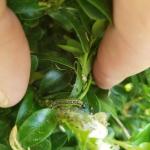 Box Tree Moth has been detected in the following Massachusetts communities: Bourne, Sandwich, and Barnstable. A map of these locations is available at MDAR’s Invasive Pest Dashboard. If you believe you have found this insect, please take a photo, note your location, and report it immediately to the MA Department of Agricultural Resources using their Report a Pest Form. Box tree moth caterpillars were reported to be active at certain locations on Cape Cod, MA as of the week of April 19th. See Landscape Message #3 and the Cape Cod Region Report.
Box Tree Moth has been detected in the following Massachusetts communities: Bourne, Sandwich, and Barnstable. A map of these locations is available at MDAR’s Invasive Pest Dashboard. If you believe you have found this insect, please take a photo, note your location, and report it immediately to the MA Department of Agricultural Resources using their Report a Pest Form. Box tree moth caterpillars were reported to be active at certain locations on Cape Cod, MA as of the week of April 19th. See Landscape Message #3 and the Cape Cod Region Report.
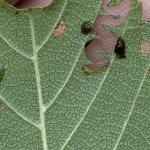
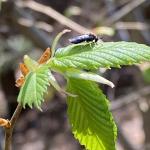 Elm Zigzag Sawfly has been detected in the following Massachusetts communities: Becket, Chester, Windsor, and Williamstown. If you believe you have found this insect, please take a photo, note your location, and report it immediately using MA DCR’s Massachusetts Elm Zigzag Sawfly Reporting Form. Elm zigzag sawfly adults are active as of 5/2/2024 at a previously infested site in Berkshire County (first detected in 2023). See photo courtesy of Nicole Keleher, MA DCR Forest Health Program.
Elm Zigzag Sawfly has been detected in the following Massachusetts communities: Becket, Chester, Windsor, and Williamstown. If you believe you have found this insect, please take a photo, note your location, and report it immediately using MA DCR’s Massachusetts Elm Zigzag Sawfly Reporting Form. Elm zigzag sawfly adults are active as of 5/2/2024 at a previously infested site in Berkshire County (first detected in 2023). See photo courtesy of Nicole Keleher, MA DCR Forest Health Program.
- Emerald Ash Borer is well established across most of Massachusetts. A map of these locations from the MA Department of Conservation and Recreation is available.
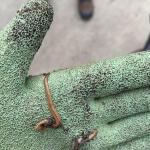
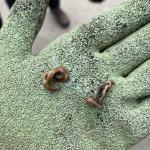 Hammerhead Worms: Also known as flatworms or land planarians, belong to Phylum Platyhelminthes (flat worms) rather than Arthropoda (arthropods) which makes them different from insects and their relatives. Class Insecta is the taxonomic classification of the Insects, whereas hammerhead worms belong to Class Turbellaria. A few common species of non-native hammerhead worms noted in New England include but are not limited to: Bipalium kewense, Bipalium adventitium, and Bipalium pensylvanicum. For more information, see this article in Hort Notes on Hammerhead Worms in New England.
Hammerhead Worms: Also known as flatworms or land planarians, belong to Phylum Platyhelminthes (flat worms) rather than Arthropoda (arthropods) which makes them different from insects and their relatives. Class Insecta is the taxonomic classification of the Insects, whereas hammerhead worms belong to Class Turbellaria. A few common species of non-native hammerhead worms noted in New England include but are not limited to: Bipalium kewense, Bipalium adventitium, and Bipalium pensylvanicum. For more information, see this article in Hort Notes on Hammerhead Worms in New England.
Sightings of these organisms have increased in recent years, possibly due to warming winters and wet summers. Hammerhead worms are predators that prefer to feed on earthworms; however, depending upon the species involved, they may not be an effective predator of certain species of jumping worms. Again in 2024, reports of hammerhead worms have come from parts of Massachusetts (in this case, Martha’s Vineyard; see photos) with questions about safety. Hammerhead worms are known to produce a neurotoxin (tetrodotoxin) which they use in self-defense and to subdue prey. Luckily, hammerhead worms do not produce enough tetrodotoxin to be lethal to humans, but if the neurotoxin comes into contact with exposed skin, irritation may occur. It is advised that handling hammerhead worms should be avoided, and hands or exposed skin be washed with soap and water following any accidental contact.- Jumping Worms are non-native earthworms that impact natural ecosystems. Available resources include a fact sheet about earthworms in Massachusetts and jumping worm FAQ’s.
- Spotted Lanternfly now has established populations in the following locations in Massachusetts: Holyoke, Springfield, West Springfield, Agawam, Fitchburg, Worcester, Shrewsbury, Southborough, Ashland, Wellesley, Weston, and Chelmsford. If you believe you have found this insect, please take a photo, note your location, and report it immediately using the Spotted Lanternfly Report Form. Available resources include a map of spotted lanternfly locations in Massachusetts from the MA Department of Agricultural Resources, MDAR’s spotted lanternfly fact sheet, UMass Extension’s Spotted Lanternfly Management Guide, and an SLF InsectXaminer episode.
Medically Important Pests:
- Ticks are a serious public health concern and may be active in managed landscapes any time temperatures are above freezing. Encounters with deer ticks can increase in New England in April, October, and November; however, precautions should be taken year-round to prevent tick bite exposure. Available resources include tick information from Cape Cod Cooperative Extension, personal protective measures, and a list of potential tick testing resources. The New England Center of Excellence in Vector-Borne Diseases (NEWVEC) also provides the latest tick information and resources.
- Mosquitoes and the diseases they vector are also a serious public health concern in Massachusetts by summer. Available resources include Mosquito Repellents from the Department of Public Health and Prevent Mosquito Bites from the Centers for Disease Control and Prevention. The Massachusetts Department of Public Health tests for Eastern Equine Encephalitis (EEE) and West Nile Virus (WNV) from June to October. Beginning in June, Massachusetts risk maps will be available.
Tree & Shrub Insect & Mite Pest Suggested Scouting:
- Andromeda Lace Bug is most commonly encountered on Japanese andromeda, however other host plants may be impacted. Most activity from this insect occurs between late May through September, with several generations occurring per year. Both nymphs and adults feed on host plant leaf undersides and cause white/yellow-colored spots or chlorosis to occur on host plant leaf surfaces.
- Azalea Lace Bug is a pest of both deciduous and evergreen azaleas (Rhododendron spp.), however resistance has been reported in Rhododendron atlanticum, R. arborescens, R. canescens, R. periclymenoides, and R. prunifolium. The insects feed on host plant leaf undersides, and cause chlorosis on leaf surfaces. Azalea lace bugs are active from 120+ GDD’s throughout the summer.
- Bagworm is overwintering on Juniperus spp., Thuja spp., Quercus spp., Platanus spp., and others as 500-1000 eggs can be found in the bags of last season’s deceased females. Now is the time to remove and destroy overwintering bags of eggs prior to egg hatch at approximately 600 GDD’s (approx. mid-June).
- Balsam Twig Aphid overwinters as eggs on host plant bark, trunks, and branches (primarily Abies and Picea spp.). Eggs hatch roughly between 30-120 GDD’s, approximately April-May. Nymphs quickly mature into stem mothers, which produce 20-40 young (each) without laying eggs. These young feed on buds and tender needles, and cause most of their feeding damage during that time. Scout now for curled or stunted needles from feeding in prior years.
 Balsam-fir Root Aphid was reported by a Christmas tree grower in Athol, MA on young transplants on 4/30/2024. This aphid alternates between ash or lilac species host plants and the roots of fir, including Fraser fir (Abies fraseri) such as what is pictured here. It is uncertain the amount of damage this root aphid may cause on fir species host plants. It is likely negligible on mature or established trees without additional stress factors. Young plants may experience some loss of fine roots when aphid numbers exceed 100 per seedling.
Balsam-fir Root Aphid was reported by a Christmas tree grower in Athol, MA on young transplants on 4/30/2024. This aphid alternates between ash or lilac species host plants and the roots of fir, including Fraser fir (Abies fraseri) such as what is pictured here. It is uncertain the amount of damage this root aphid may cause on fir species host plants. It is likely negligible on mature or established trees without additional stress factors. Young plants may experience some loss of fine roots when aphid numbers exceed 100 per seedling. - Black Turpentine Beetle overwinters as an adult in the bark of its host plants. Adults may become active as temperatures rise, typically by mid-April to mid-May. Attacked host trees may ooze 1.6 inch diameter red or white masses of pitch from the lower 6 feet of the trunk. Pitch pine, eastern white pine, and other species of pine or spruce may be hosts for this insect. Frequently an issue on stressed trees in eastern Massachusetts. Favored by drought or flooding conditions.
- Boxwood Leafminer is overwintering as a partially developed larva within Buxus spp. leaves. Larvae will become active as temperatures warm, with pupae present by late April. Adult emergence occurs by mid-May, with pupal cases left behind clinging to leaves. Shake bushes in late April to detect flying adults. Resistant varieties of boxwood are available; see preceding link.
- Boxwood Mite feeds on upper and lower leaf surfaces of Buxus spp. hosts. Overwintered eggs hatch into larvae in the spring, which mature into nymphs and eventually adults. The entire life cycle takes approximately 18-21 days. Most feeding injury occurs in the spring and hosts may appear off-color.
- Boxwood Psyllid nymphs have overwintered within eggshells inserted between bud scales last summer. As soon as buds expand, nymphs will emerge and begin feeding on Buxus spp. developing buds and leaves. Upward cupping and yellowing of leaves can be a sign of previous or current season’s damage. Dormant season horticultural oil applications may be made in the spring, as temperatures and weather conditions allow.
- Cankerworms can be found feeding on similar host plants in the spring, despite fall and spring cankerworm being different species of insects. Spring cankerworm adult moths are active in February and March, laying masses of 100 or so eggs in the rough bark of larger branches or the trunk of the host plant. Fall cankerworm adults laid their masses of eggs on host plant branches and twigs, back in late November and early December of last year (sometimes the current year’s January). Egg hatch of both species will occur by approximately mid-May, with caterpillar feeding through roughly the end of June.
- Cooley Spruce Gall Adelgid typically overwinters as an immature female near spruce twig terminals. By early spring, this female matures into a stem mother which will lay hundreds of eggs on lateral terminals. Following egg hatch, nymphal feeding induces gall formation on spruce hosts. Green galls on spruce may be removed and destroyed. On Douglas fir, the Cooley spruce gall adelgid’s alternate host, look for woolly masses in the spring and distorted or crooked needles. Do not plant spruce and Douglas fir close together when possible.
- Dogwood Borer is a species of clearwing moth whose larvae bore not only into dogwood (Cornus), but hosts also include flowering cherry, chestnut, apple, mountain ash, hickory, pecan, willow, birch, bayberry, oak, hazel, myrtle, and others. Kousa dogwood appears to be resistant to this species. Signs include the sloughing of loose bark, brown frass, particularly near bark cracks and wounds, dead branches, and adventitious growth. The timing of adult emergence can be expected when dogwood flower petals are dropping and weigela begins to bloom. Adult moth flights continue from then until September.
- Dogwood Sawfly overwinters as a larva in an overwintering “cell” created in soft, decaying wood material. Pupation occurs in the spring, and adults may emerge by late May through July. Eggs are laid in the underside of the host plant leaf, in groups of 100 or more.
- Eastern Spruce Gall Adelgid overwinters as a partially grown female, maturing into a stem mother by early spring. Stem mothers lay 100-200 eggs by budbreak. Eggs hatch and nymphs feed on the needles of their Picea spp. hosts. As green galls develop, prune out and destroy when possible.
- Eastern Tent Caterpillar overwintering eggs hatch in the spring and caterpillars emerge as cherry leaves begin to open. Look for groups of caterpillars feeding in silken tents at that time. Egg masses, caterpillars, and small tents are active now.
- Elm Leaf Beetle overwinters as an adult in protected areas, such as the loose bark of trees. Sometimes, they enter homes in search of a safe winter haven, and become a nuisance. As host plant leaves emerge, beetles fly back to chew small, semi-circular holes in the leaves. Eggs are laid in clusters on leaves and resemble pointy footballs. Each female can lay 600-800 eggs.

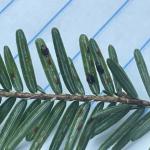 Elongate Hemlock Scale is primarily a pest of hemlock and fir. Overwintered fertilized females or their eggs will become active with warming temperatures, with egg hatch generally occurring by the end of May or the beginning of June. At that time, crawlers will be present before they settle to feed on a needle. Colletotrichum fioriniae was observed on elongate hemlock scales in Lynnfield, MA on 2/23/2024 and again in Manchester, MA on 3/19/2024 by Richard Grant (see photos). C. fioriniae is an endophytic fungus that lives within the needles of hemlock. Up to 90% mortality can occur in elongate hemlock scale if this fungus invades the insect. Scales appear coated in a black material, looking similar to sooty mold (it is not sooty mold). This fungus was reported as active in elongate hemlock scale populations in western MA in 2023 as well.
Elongate Hemlock Scale is primarily a pest of hemlock and fir. Overwintered fertilized females or their eggs will become active with warming temperatures, with egg hatch generally occurring by the end of May or the beginning of June. At that time, crawlers will be present before they settle to feed on a needle. Colletotrichum fioriniae was observed on elongate hemlock scales in Lynnfield, MA on 2/23/2024 and again in Manchester, MA on 3/19/2024 by Richard Grant (see photos). C. fioriniae is an endophytic fungus that lives within the needles of hemlock. Up to 90% mortality can occur in elongate hemlock scale if this fungus invades the insect. Scales appear coated in a black material, looking similar to sooty mold (it is not sooty mold). This fungus was reported as active in elongate hemlock scale populations in western MA in 2023 as well.- Euonymus Caterpillar tiny, overwintered larvae have spent their time beneath eggshells from last year. As temperatures increase in the spring, groups of caterpillars will begin feeding on newly emerging Euonymus spp. leaves. Additional resources include an InsectXaminer episode about euonymus caterpillar.
- Euonymus Scale overwinters as a fertilized female. Eggs are laid beneath dark brown female scale covers in the early spring. Egg hatch occurs over a 2-3 week period, with crawlers present by early June. While Euonymus spp. host plants are preferred, additional host plants have been reported.
- European Elm Scale is a non-native scale that is widespread in North America on native and European elms, in addition to hackberry and Zelkova. Adult females are black with a ring of white fibers around their bodies and may be found in branch forks or rough/creviced areas of the bark. By the end of June, females will produce eggs that hatch into crawlers. Crawlers will disperse to the underside of elm leaves and leaf midveins to feed.
- European Pine Sawfly eggs have overwintered in slits in last year’s needles. Egg hatch begins in approximately late-April and early May.
- Fletcher Scale is a soft scale pest of yew, juniper, and arborvitae. Feeding scales, especially on yew, result in honeydew and sooty mold, needle yellowing, and at times, premature needle drop. There is one generation per year. Overwintered second instar nymphs can be targeted between 38-148 GDD’s, base 50°F. Nymphs develop and adult females lay eggs (on average 500-600) in May that hatch by June. Dead females conceal egg masses beneath. Crawlers migrate short distances to branches and may be concentrated on certain branches of a particular plant.
- Forest Tent Caterpillar egg masses overwinter and will hatch as leaves expand in the spring. Small caterpillars will search for expanding flower and leaf buds to begin feeding on.
- Hemlock Looper collectively refers to two species of geometrid (inchworm; looper) caterpillars. Overwintered eggs hatch by late May or early June, at which time young larvae begin their messy feeding on host plant needles. Hemlock and balsam fir are preferred hosts.
- Hemlock Woolly Adelgid has been favored this winter by the mild temperatures we’ve experienced in Massachusetts, according to the MA Department of Conservation and Recreation. Very little overwintering mortality has been measured at sites sampled across the state. Overwintered sistens generation females produce viable eggs in February and March.
- Holly Leafminer is the common name of up to seven species of leaf mining flies that feed on holly (Ilex spp). Phytomyza ilicicola is usually referred to as the native holly leafminer. This species is known to feed on Ilex opaca, I. crenata, and related cultivars; however, it only lays its eggs in American holly (Ilex opaca). Some research suggests that the native holly leafminer may lay its eggs in other Ilex species, but that the larvae are unable to complete their development. Adult flies are known to emerge over a period of 6 or so weeks in the spring by mid-May (192-298 GDD’s, base 50°F). Phytomyza ilicis is usually only referred to as the holly leafminer, and it is a non-native species introduced from Europe and only feeds on Ilex aquifolium. (The native holly leafminer does not develop on I. aquifolium.) The biology and damage this insect causes is similar to that of the native holly leafminer, with the exception of the fact that eggs are laid in the midvein of the leaf and young larvae tunnel in the vein until the fall. Adults may be present mid-late May (246-448 GDD’s, base 50°F).
- Honeylocust Plant Bug feeding results in tiny yellowish-brownish spots on leaves, leaf distortion, and in some cases, defoliation. (There are at least 7 species of plant bugs that feed on honeylocust, Gleditsia triacanthos.) There is one generation per year. Immatures and adults feed on foliage and light to moderately damaged foliage may persist throughout the growing season. Honeylocust plant bugs overwinter as eggs laid just beneath the bark surface of 2 and 3 year old twigs. Eggs hatch just after vegetative bugs of the host begin to open. Young nymphs crawl to the opening leaflets and begin feeding and the most significant damage occurs at that time, when the insect is hidden from view. Nymphs develop into adults around May-July. This insect can be targeted between 58-246 GDD’s, base 50°F.
- Imported Willow Leaf Beetle adults overwinter in loose bark or other sheltered areas near susceptible Salix and Populus spp. host plants. Once the host plant leaves emerge in the spring, adults will begin to feed and lay tiny, yellow eggs in clusters on leaf undersides. Additional resources include an InsectXaminer episode about imported willow leaf beetle.
- Japanese Cedar Longhorned Beetle cause damage to arborvitae, cypress, juniper, and cedar (Chamaecyparis). Feeding damage from the larvae of this species causes branch dieback, which is typically not noticed until the springtime following the initial infestation. 1/8-inch oval exit holes, galleries beneath the bark (in the cambium and xylem), and frass may be signs of the activity of this insect. Take precautions to avoid host plant stress. May go unnoticed until a plant needs to be removed.
- Lecanium Scales, including most notably in Massachusetts, the oak lecanium, are soft scales that overwinter on host plant twigs as second instar immatures. In the spring, these immatures begin feeding and mature into hemispherical shaped adult females who lay their eggs by late May and into June. Between April and May, much honeydew (sugary excrement) may be produced by the active adult females.
- Lilac Borer is a clearwing moth pest of lilac, privet, fringetree, and ash. (It is also known as the ash borer, not to be confused with the emerald ash borer.) Adults mimic paper wasps. Larvae are wood-boring, and signs and symptoms include branch dieback, holes, and occasionally, sawdust-like frass accumulated on bark. Larvae bore into stems, trunks, and branches, chewing an irregularly shaped entrance hole. Peak adult moth flights may occur in the northern portion of this insect’s range in June and is usually over by August 1st. Pheromone traps can be used to time adult emergence. Adult females lay flattened, oval, and tan eggs that are deposited singly or in clusters on bark crevices, ridges, and sometimes smooth bark; but usually laid in or near wounds in the bark. On average, 395 eggs are laid by each female. After hatch, larvae chew into the bark and feed laterally and then vertically in phloem tissue. Larvae overwinter in tunnels in the final instar and resume feeding in the spring. Adults emerge through a round exit hole (4-5 mm. in diameter). This insect may be targeted between 200-299 GDD’s, base 50°F.
- Lily Leaf Beetle, while not a pest of trees and shrubs, can be an important insect found in ornamental landscapes. As soon as lilies break through the ground in the spring, bright red overwintered adult beetles begin feeding on the foliage. This typically occurs in April, with adults mating and laying eggs by May; 250-450 eggs may be laid per female. Additional resources include an InsectXaminer episode about lily leaf beetle.
- Magnolia Scale overwinters as nymphs (immatures) found on 1 and 2-year old twigs of the host plant. Nymphs begin feeding as temperatures warm in the spring, molting once by late April or May and again by early June.
- Pine Bark Adelgid overwinters in an immature form which begins feeding again as springtime temperatures increase. This is the time when the insects begin secreting a white, waxy layer over their bodies. High populations can make the trunks of eastern white pine appear as if coated in snow. Typically, management is not necessary. Syringing (washing adelgids off the trunk of larger trees with a strong jet of water) is an option.
- Pitch Mass Borer overwinters in the pitch mass found on the host plant. This insect tunnels beneath the bark, into the cambium. It may take up to two years for the pitch mass borer to mature. Pupation typically occurs by the end of May through June, in time for adult clearwing moth emergence in July and August.
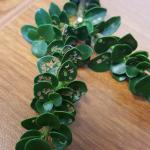
 Redheaded Flea Beetle (Systena frontalis) has been identified as a native pest of nurseries in many locations in the eastern United States. Suspected redheaded flea beetle damage was seen on Ilex crenata 'Dwarf Pagoda' (Dwarf Pagoda Japanese holly) on 3/27/2024 that was purchased in Massachusetts but may have originated in NJ. While identification of this species of insect is uncertain based on host plant damage alone, it appears to be a reasonable and educated assumption. Redheaded flea beetles are known to feed on a wide variety of host plants. These include but are not limited to: cabbage, beans, beets, blueberries, and other agricultural crops as well as Physocarpus, Weigelia, Cornus, Forsythia, Itea, Hydrangea, and Ilex. Adult beetles are active and feed from approximately late-June to mid-September on the upper and lower leaf surfaces of their hosts. This can cause damage that looks like skeletonization and eventually holes in the leaves. Leaves appear covered in brown patches as in these photos. This damage was caused last season on this evergreen plant.
Redheaded Flea Beetle (Systena frontalis) has been identified as a native pest of nurseries in many locations in the eastern United States. Suspected redheaded flea beetle damage was seen on Ilex crenata 'Dwarf Pagoda' (Dwarf Pagoda Japanese holly) on 3/27/2024 that was purchased in Massachusetts but may have originated in NJ. While identification of this species of insect is uncertain based on host plant damage alone, it appears to be a reasonable and educated assumption. Redheaded flea beetles are known to feed on a wide variety of host plants. These include but are not limited to: cabbage, beans, beets, blueberries, and other agricultural crops as well as Physocarpus, Weigelia, Cornus, Forsythia, Itea, Hydrangea, and Ilex. Adult beetles are active and feed from approximately late-June to mid-September on the upper and lower leaf surfaces of their hosts. This can cause damage that looks like skeletonization and eventually holes in the leaves. Leaves appear covered in brown patches as in these photos. This damage was caused last season on this evergreen plant.- Rhododendron Borer is one of the smallest of the native clearwing moths. Adult emergence may begin in May and can last through July, depending upon local temperatures. Rhododendron are preferred host plants, with the larvae of this species boring into stems, often near the base of plants. Injured plant parts may be more attractive to these insects.
- Snowball Aphid overwinters as an egg on the twigs and buds of Viburnum spp. hosts. Egg hatch occurs at the same time host plant buds are opening in the spring. Newly hatched aphids will begin to feed on and distort the newly developing leaves of their hosts. Aphids may be protected from contact insecticides within curled leaves.
- Southern Pine Beetle has been trapped in Massachusetts since 2015. By 2022 and 2023, southern pine beetle has reached outbreak conditions in small areas of the state, killing pitch pine (Pinus rigida). (Particularly on Martha’s Vineyard and Nantucket islands in MA.) If you believe you have found infested pitch pine in Massachusetts, please report southern pine beetle here.
- Spruce Bud Scale overwinters as an immature scale on the undersides of host plant needles. Once spring temperatures warm, the dormant scales become active by late March and in April female spruce bud scales move to host plant twigs. Adult females are reddish-brown and round, and usually found at the base of new twig growth.
- Spruce Spider Mite is a cool season mite which causes most of its feeding damage on coniferous hosts in the spring and fall. Monitor for discolored needles and the mites themselves. Monitoring for spruce spider mite can be done by shaking 3-4 branches over a white piece of paper and viewing mites with a hand lens.
- Taxus Mealybug is commonly a pest of Taxus spp. in New England, but can also be found on dogwood, rhododendron, Prunus spp., maple, andromeda, and crabapple. First instar nymphs overwinter, and in April and May it might be difficult to find these insects. However, by mid-June the population can increase considerably. Taxus mealybug feeding can lead to sparse plants covered in honeydew (sugary liquid excrement).
- Tuliptree Scale is a soft scale pest of Liriodendron and Magnolia spp. among others. Second instar nymphs overwinter, begin feeding as temperatures warm in the spring, and mature into adults by the late spring/early summer.
- Viburnum Leaf Beetle overwinters on susceptible viburnum as eggs laid in pits chewed near the ends of twigs last season. These egg laying locations are covered with an oval-round cap. Prune out and destroy infested twigs prior to egg hatch in May.
- White Pine Aphid eggs overwinter in rows on the needles of their host plants. Egg hatch will occur as spring temperatures begin to warm. Aphids may feed on the needles, twigs, and small branches of their host plants.
- White Pine Weevil overwinters as an adult in the leaf litter in sheltered areas near host plants. As spring temperatures warm, adults fly to the leaders of Pinus and Picea spp. hosts where they mate, dig round holes in the bark, and deposit 1-5 tiny eggs in the cavity. Eggs hatch and the larvae tunnel as they feed, killing the previous season’s leader. Adult white pine weevils are active in March (through May), as soon as 7 GDD’s are reached.
- White Spotted Pine Sawyer is a native longhorned beetle that is often confused for the invasive Asian longhorned beetle (see entry above). White spotted pine sawyer adults emerge in late May throughout July in MA. This insect completes its life cycle in weakened or recently dead conifers, particularly eastern white pine (Pinus strobus). It is not a significant pest. However, if you are unsure of the identification of a longhorned beetle, always take a photo and report it. You can report suspicious insects at the MA Department of Agricultural Resources Introduced Species Outreach Project Report a Pest Form.

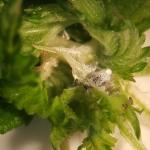 Woolly Apple Aphid overwinters as eggs in the cracks and crevices of Ulmus spp. host plants. As spring temperatures warm, these eggs hatch and stem mothers begin feeding on developing elm leaves. Their feeding and the feeding of the wingless nymphs they produce causes leaf distortion and a rosette to form on elm. If no elm is present, the aphids will complete their life cycle on apple year-round. Woolly apple aphid feeding distortion was seen on new elm foliage on the UMass Amherst campus on 5/1/2024.
Woolly Apple Aphid overwinters as eggs in the cracks and crevices of Ulmus spp. host plants. As spring temperatures warm, these eggs hatch and stem mothers begin feeding on developing elm leaves. Their feeding and the feeding of the wingless nymphs they produce causes leaf distortion and a rosette to form on elm. If no elm is present, the aphids will complete their life cycle on apple year-round. Woolly apple aphid feeding distortion was seen on new elm foliage on the UMass Amherst campus on 5/1/2024.- Woolly Beech Leaf Aphid overwinters as eggs in host plant bark crevices near buds. At budbreak, eggs hatch and wool covered aphids begin feeding on host plant leaf undersides (Fagus spp.). Even though aphid populations may be very noticeable, they seldom require chemical management.
- Woolly Elm Aphid overwinters as eggs hidden in cracks and crevices of elm bark. As leaves unfold in the spring, eggs hatch and young aphids feed on the underside of elm leaf tissue. These aphids mature and give birth to hundreds of additional females. Feeding causes leaves to curl around the aphids. Curled leaves may also turn reddish brown.
Beneficials/Non-Pests:
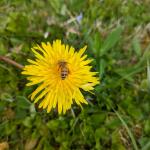
 Is it a bee or a fly? You may be noticing a lot of enthusiastic pollinators foraging on springtime flowers as our green spaces wake up. But can you spot a fly in bee's clothing? Certain species of flies have figured out how to very convincingly mimic bees to benefit from the reputation stinging insects have. For example, many hover flies (Syrphidae) and drone flies (Eristalis spp.) are convincing bee mimics. Here are a few pointers to help you distinguish the flies from the bees. However, remember, that both are beneficial insects (and not pests)!
Is it a bee or a fly? You may be noticing a lot of enthusiastic pollinators foraging on springtime flowers as our green spaces wake up. But can you spot a fly in bee's clothing? Certain species of flies have figured out how to very convincingly mimic bees to benefit from the reputation stinging insects have. For example, many hover flies (Syrphidae) and drone flies (Eristalis spp.) are convincing bee mimics. Here are a few pointers to help you distinguish the flies from the bees. However, remember, that both are beneficial insects (and not pests)!
- Flies (Diptera):
- Bees (Hymenoptera):
- Have 4 wings (2 pairs).
- May have pollen baskets on the legs which may be holding large amounts of pollen, as in this photo.
- Often have geniculate antennae (as in the honeybee); however, solitary bees may have antennae in another form.
Report by Tawny Simisky, Extension Entomologist, UMass Extension Landscape, Nursery & Urban Forestry Program
Landscape Weeds
For information about identification of weeds noted below, check out UMass Extension's Weed Herbarium.
Time is running out for the application of preemergence herbicides for the control of crabgrass and other annual grasses as the flowering period of the phenological indicator plant forsythia (Forsythia intermedia) has passed. In turf areas that have not yet received a preemergence application and crabgrass has germinated, the application of a sprayable formulation on dithiopyr will control seedling crabgrass while supplying preemergence control of seedlings to come in the next few weeks.
Garlic mustard, Alliaria petiolata, considered invasive in Massachusetts and other northeast states, is a biennial weed. Second year plants are beginning to flower and produce fruit. An herbicide application now will control the second-year plants before they produce seed, as well as the first-year seeding plants that are germinating below the canopy of the second-year plants.
Many winter annual weeds are coming out of winter dormancy and are beginning to flower in turf and landscape areas. The recent warm weather has pushed most winter annual weeds in turf and landscapes to full flower. Attempting to control these weeds now will decrease the number of seeds they produce. Winter annuals will complete their life cycle as the weather continues to warm. A fresh layer of landscape mulch will control them by smothering. Dense populations of winter annual weeds in turf areas that might be competing with newly establishing turf from seed may warrant the application of a broadleaf herbicide combination. Common winter annual weeds being observed now are include mouse-ear cress (Arabidopsis thaliana), thymeleaf sandwort (Arenaria serpyllifolia), shepherd's-purse (Capsella bursa-pastoris), hairy bittercress (Cardamine hirsuta), sticky chickweed (Cerastium viscosum), spring whitlowgrass (Draba verna), henbit (Lamium amplexicaule), red deadnettle (Lamium purpureum), Virginia pepperweed (Lepidium virginicum), knawel (Scleranthus annuus), common chickweed (Stellaria media), corn speedwell (Veronica arvensis), and purslane speedwell (Veronica peregrina).
Landscape mulch should be the first defense against weeds in landscape beds. Apply mulches at the beginning of the season before summer annual weeds germinate. Smother small winter annual weeds with mulch. Freshly mulched landscape beds will not immediately require a preemergence herbicide application because the fresh mulch should supply adequate summer annual weed control in the short term. Apply a preemergence herbicide to mulches that have not been freshly mulched. Apply preemergence herbicides on top of landscape mulches. Compost is not an effective landscape mulch.
Lesser celandine, also called fig buttercup, fig-crowfoot, or dusky maiden (Ficaria verna or Ranunculus ficaria), is an herbaceous, invasive, perennial plant found throughout New England. This species is a spring ephemeral, with shiny, dark green, kidney-shaped leaves and bright-yellow, glossy flowers with 8 to 12 petals. Lesser celandine reproduces by bulblets, tuberous roots, and seeds. As a spring ephemeral, it is only apparent in the spring and is dormant the rest of the year, so it is often difficult to determine if an herbicide worked or the symptoms observed are just the species going dormant later in the spring. Herbicides known to effectively control lesser celandine in turf are triclopyr and dicamba. Products that contain both herbicides are the best choice. Populations of lesser celandine in landscape beds can be controlled with directed-spray applications of glyphosate. For early occurrences of this weed in new locations, consider digging plants up and disposing of them in a manner that will prevent their further spread.
Tree seedlings are continuing to germinate in landscape beds with seedlings commonly reaching 4 to 5 inches tall. These seedlings can be treated with pelargonic acid. Another option would be to cut these seedlings with a gas, electric, or battery powered hedge shear at the soil surface, and then mulch over it. The organic/non-chemical products do not translocate and therefore will not provide effective control of these young tree seedlings. Tree seedlings in turf areas should be managed with mowing so an herbicide application is not necessary.
Do not attempt to control Japanese knotweed now, as herbicide applications are not effective when applied in the early part of the growing season. Stay tuned for knotweed management information in upcoming Landscape Messages.
Report by Randy Prostak, Weed Specialist, UMass Extension Landscape, Nursery, and Urban Forestry Program
Additional Resources
Pesticide License Exams - The MA Dept. of Agricultural Resources (MDAR) is now holding exams online. For more information and how to register, go to: https://www.mass.gov/pesticide-examination-and-licensing.
To receive immediate notification when the next Landscape Message update is posted, join our e-mail list or follow us on Facebook.
For a complete listing of landscape, nursery, and urban forestry program upcoming events, see our calendar at https://ag.umass.edu/landscape/upcoming-events.
For commercial growers of greenhouse crops and flowers - Check out UMass Extension's Greenhouse Update website.
For professional turf managers - Check out our Turf Management Updates.
For home gardeners and garden retailers - Check out our home lawn and garden resources.
Diagnostic Services
UMass Laboratory Diagnoses Landscape and Turf Problems - The UMass Extension Plant Diagnostic Lab is available to serve commercial landscape contractors, turf managers, arborists, nurseries and other green industry professionals. It provides woody plant and turf disease analysis, woody plant and turf insect identification, turfgrass identification, weed identification, and offers a report of pest management strategies that are research based, economically sound and environmentally appropriate for the situation. Accurate diagnosis for a turf or landscape problem can often eliminate or reduce the need for pesticide use. For sampling procedures, detailed submission instructions and a list of fees, see the Plant Diagnostic Laboratory web site.
Soil and Plant Nutrient Testing - The University of Massachusetts Soil and Plant Nutrient Testing Laboratory is located on the campus of the University of Massachusetts at Amherst. Testing services are available to all. The lab provides test results and recommendations that lead to the wise and economical use of soils and soil amendments. For more information, including current turn-around times, visit the UMass Soil and Plant Nutrient Testing Laboratory web site. The lab is currently accepting orders for Routine Soil Analysis (including optional Organic Matter, Soluble Salts, and Nitrate testing), Particle Size Analysis, Pre-Sidedress Nitrate (PSNT), Total Sorbed Metals, and Soilless Media (no other types of soil analyses available at this time). Check for current turnaround time. Please plan for the fact that date of receipt in the lab is affected by weekends, holidays, shipping time, and time for UMass Campus Mail to deliver samples to the lab.
Tick Testing - The UMass Center for Agriculture, Food, and the Environment provides a list of potential tick identification and testing options at https://ag.umass.edu/resources/tick-testing-resources.
Acknowledgements: UMass Extension gratefully acknowledges the support of the following funding sources for the production of the Landscape Message –
- The Massachusetts Nursery and Landscape Association Fund
- The Massachusetts Department of Conservation and Recreation, Award #ISADCR28219926UMA24A
- Stakeholders like you! The Landscape Message is partially supported by educational program user fees.